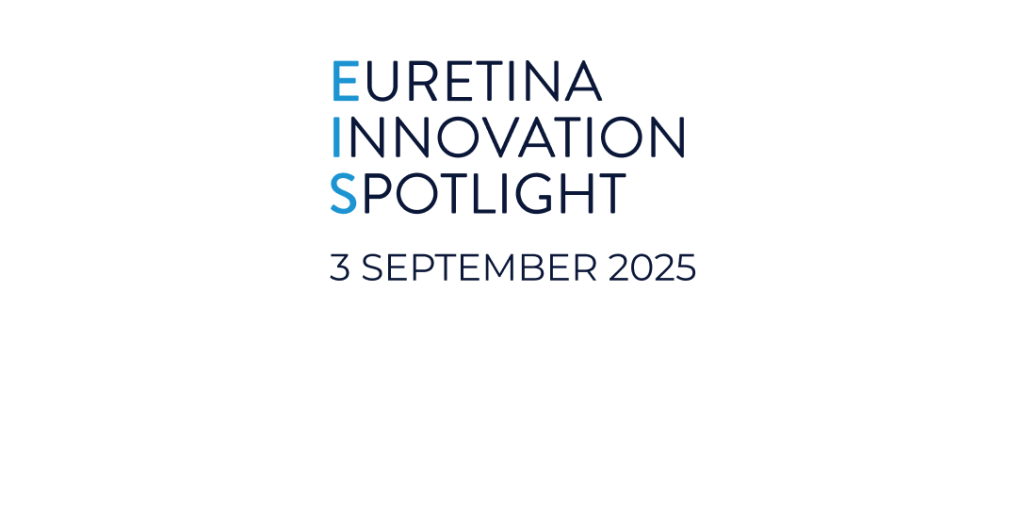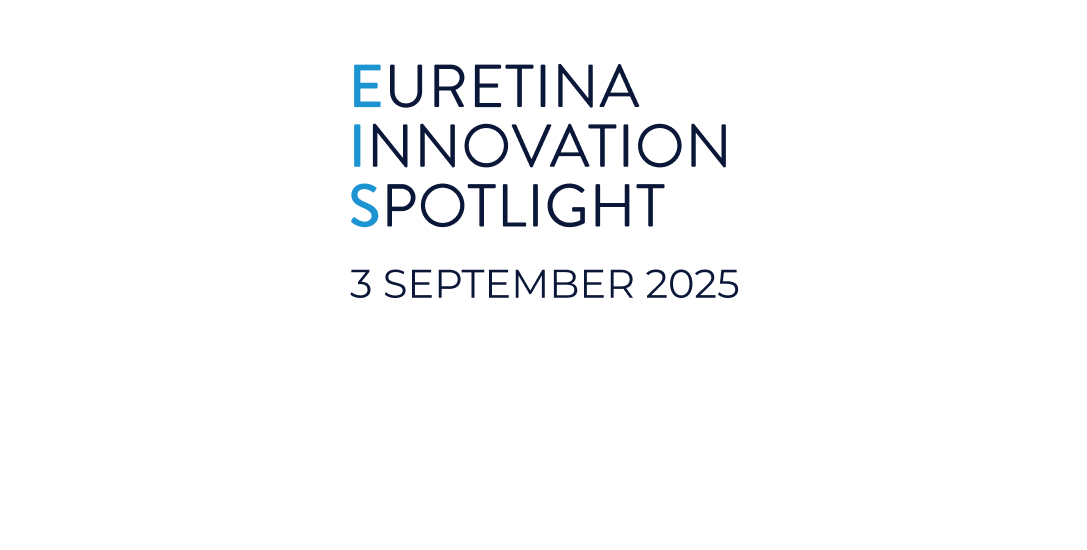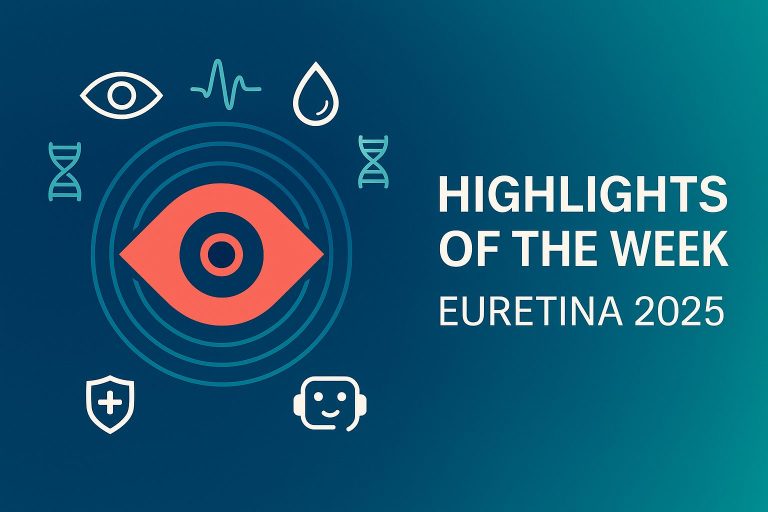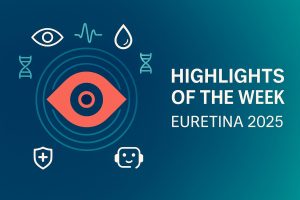The EURETINA congress closed with a ‘Highlights of the week’ session, chaired by Anat Loewenstein, Martin Zinkernagel and Nicole Eter. The programme was organised in three sections with panel input from Tunde Peto and Edoardo Midena (Section 1), Aude Coutourier, Grazia Pertile and Heinrich Heimann (Section 2), and Bahram Bodaghi with Heinrich Heimann (Section 3). Below, key items are summarised with the original session noted, along with a brief synopsis as to why they were included in the highlights package.
A reminder – all of these session are available to view On Demand for registered attendees until the end of the year.
Section 1 — AMD, Imaging, Diabetes
Supplements in geographic atrophy — Tiarnan Keenan (USA). Original session: Nonexudative AMD.
A concise evidence review on dietary supplements in GA, distinguishing what is supported by data from what remains speculative. Practical emphasis is on whether—and how—to incorporate supplements into patient-facing recommendations.
Gene therapy for neovascular AMD — Arshad Khanani. Original session: Neovascular AMD.
Overview of current vector strategies for durable VEGF suppression, with attention to trial design, safety monitoring and the gap between controlled settings and routine service delivery. Framed against the ongoing goal of reducing treatment burden without compromising disease control.
Inherited retinal diseases: imaging for safety evaluation — Bart Leroy. Original session: Global Transformation of Disease Understanding and Management through Imaging: Are we Ready to Step into the Future?
Positions multimodal imaging as the backbone for safety and efficacy monitoring in IRD interventions—baseline characterisation, longitudinal follow-up and quantifiable change. Selected to set out what is known, where clinical information gaps persist, and how imaging frameworks can help close those gaps.
Retinal sensitivity and retinal ischaemia in diabetic retinopathy: a longitudinal cohort study — Noemi Lois (Belfast, UK). Original session: Diabetic Retinopathy.
Longitudinal mapping of functional sensitivity against ischaemic change, highlighting structure–function alignment beyond standard OCT/OCTA read-outs. Chosen as a new and clinically relevant look at DR progression and endpoints.
Do we need a new staging for diabetic retinopathy and macular oedema? — Stela Vujosevic (Milan, Italy). Original session: Diabetic Retinopathy & DME.
Critical appraisal of legacy DR/DME scales built around colour photography versus modern multimodal imaging and management thresholds. Included to catalyse multi-stakeholder work on a revised, practice-aligned classification for retinopathy and maculopathy.
Section 2 — Myopia, VR, Tumours
Posterior staphyloma as a determining factor in myopic traction maculopathy severity and maculopathy progression after surgery — Jorge Ruiz-Medrano (Madrid, Spain). Original session: Myopia.
Synthesises data linking posterior staphyloma—the hallmark lesion of pathologic myopia—to severity and surgical prognosis in myopic traction maculopathy. Highlighted for its direct implications for pre-operative assessment, counselling and expectation-setting.
Suprachoroidal approaches for subretinal drug delivery: devices, benefits and complication risks — Dominik Fischer (UK). Original session: Next-Generation Drug Delivery: Beyond Intravitreal Injections.
Technical review of access routes and devices aimed at the subretinal space via the suprachoroidal corridor. Focus on reliability, complication profiles and the conditions under which newer delivery methods can scale beyond specialist centres.
Belzutifan for retinal haemangioblastoma — Nikolaos Bechrakis (Germany). Original session: New Treatments in Ocular Oncology.
Early European experience with systemic HIF-pathway inhibition in retinal haemangioblastoma, including coordination between ophthalmology and oncology. Selected because the speaker will present some of the first European cases, signalling a therapy moving from concept to real-world use.
Section 3 — Uveitis, Late-breaking, AI
Post-operative endophthalmitis: prevention, molecular diagnosis and treatment strategies — Catherine Creuzot-Garcher ( France). Original session: Infections You Shouldn’t Miss.
Updates prevention bundles, sampling pathways and rapid molecular diagnostics to accelerate targeted therapy when minutes matter. Included to prompt practical discussion in an evolving area with clear procedural elements.
Improved low-contrast visual acuity and reduction in retinal ganglion cell loss: a multicentre randomized placebo-controlled double-masked trial — Sophie Bonnin (Paris, France). Original session: Late Breaking.
Reports functional gains in low-contrast VA with a corroborating structural signal on retinal ganglion cell loss reduction in a controlled design. Chosen because the combination of randomized evidence and dual functional/structural outcomes indicates potential for meaningful clinical impact.
Chatbots in retina clinics: will we soon be replaced? — Fares Antaki (USA). Original session: AI for Practice.
A pragmatic look at where conversational systems can safely streamline clinic workflows—triage prompts, patient education, letters and documentation—alongside guardrails on bias, data governance and clinician oversight.
In summary, the week’s take-homes cluster around three practical currents: measurement-led care (smarter imaging, modernised DR/DME classifications and endpoints, clearer IRD safety frameworks), anatomy- and access-guided intervention (posterior staphyloma shaping prognosis in high myopia; delivery corridors proving as decisive as molecules; oncology partnerships entering routine pathways), and operational discipline (tighter endophthalmitis prevention/diagnostics, appraisal of new randomized evidence with clinically relevant endpoints, and selective clinic automation that saves time without compromising safety).
A reminder – all of these session are available to view On Demand for registered attendees until the end of the year.









